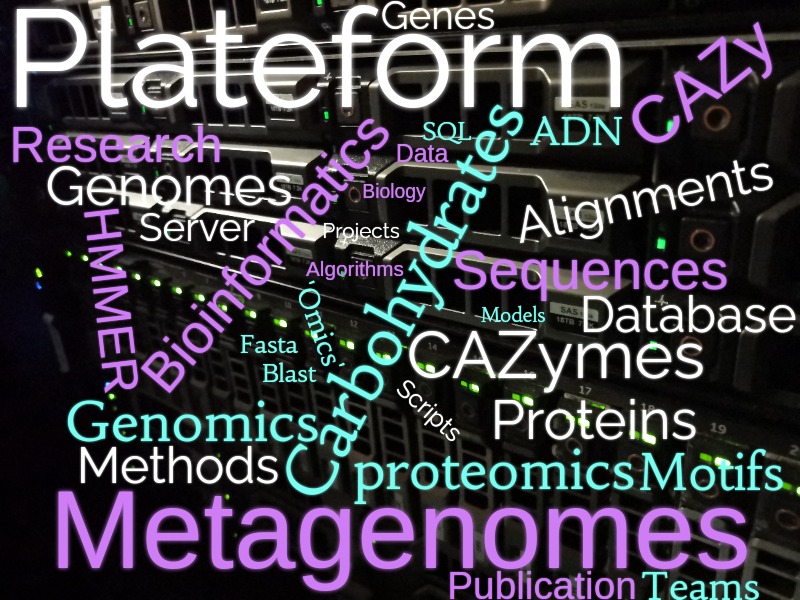The CAZy bioinformatics
This facility is based on the bioinformatics tools and curation efforts associated to the CAZy database, updated by the Glycogenomics team since its launch in September 1998.
This facility analyzes genomes and metagenomic datasets in order to identify the encoded enzymes for the assembly and breakdown of complex carbohydrates. The enzymes currently covered in our analyses include the glycoside hydrolases, glycosyltransferases, polysaccharide lyases, carbohydrate esterases, and auxiliary redox proteins such as lytic polysaccharide mono-oxygenases). We offer several levels of analysis ranging from automatic analysis to manual curation.
Access to
Academic and private companies
Cost
To be discussed (based on data volume, computer time required and human resources implicated).
Contact
- Contact AFMB : Vincent Lombard
Specific Equipement
- 1 HPC with 576 cores
- 1 HPC with 64 cores
- 4 SMP computers with 64 cores
Team contacts
Examples of publications that made use of our platform
- Hibberd MC et al. (2024) Bioactive glycans in a microbiome-directed food for children with malnutrition Nature. 625(7993):157-165
- Zeng Q et al. (2023) Stable functional structure despite high taxonomic variability across fungal communities in soils of old-growth montane forests Microbiome. 11(1):217
- Delannoy-Bruno O et al. (2022) An approach for evaluating the effects of dietary fiber polysaccharides on the human gut microbiome and plasma proteome Proc Natl Acad Sci U S A. 119(20):e2123411119
- Ostrowski MP et al. (2022) Mechanistic insights into consumption of the food additive xanthan gum by the human gut microbiota Nat Microbiol. 7(4):556-569
- Cabral L et al. (2022) Gut microbiome of the largest living rodent harbors unprecedented enzymatic systems to degrade plant polysaccharides Nat Commun. 13(1):629
- Delannoy-Bruno O et al (2021) Evaluating microbiome-directed fibre snacks in gnotobiotic mice and humans Nature. 595(7865):91-95
- Chang HW et al. (2021) Gut microbiome contributions to altered metabolism in a pig model of undernutrition Proc Natl Acad Sci U S A. 118(21):e2024446118
- Hagen LH et al. (2021) Proteome specialization of anaerobic fungi during ruminal degradation of recalcitrant plant fiber ISME J. 15(2):421-434
- Michalak L et al. (2020) Microbiota-directed fibre activates both targeted and secondary metabolic shifts in the distal gut Nat Commun. 11(1):5773.
- Li J et al. (2020) A catalog of microbial genes from the bovine rumen unveils a specialized and diverse biomass-degrading environment Gigascience. 9(6):giaa057
- Strazzulli A et al. (2020) Discovery of hyperstable carbohydrate-active enzymes through metagenomics of extreme environments FEBS J. 287(6):1116-1137
- Al-Masaudi S et al. (2019) A metagenomics investigation of carbohydrate-active enzymes along the goat and camel intestinal tract Int Microbiol. 22(4):429-435
- Liang X et al (2018) Development and characterization of stable anaerobic thermophilic methanogenic microbiomes fermenting switchgrass at decreasing residence times Biotechnol Biofuels. 11:243
- Wong MT et al. (2017) Comparative Metagenomics of Cellulose- and Poplar Hydrolysate-Degrading Microcosms from Gut Microflora of the Canadian Beaver ( Castor canadensis) and North American Moose ( Alces americanus) after Long-Term Enrichment Front Microbiol. 8:2504
- Seedorf et al. (2014) Bacteria from diverse habitats colonize and compete in the mouse gut. Cell 159, 1-14
- Ridaura et al. (2013) Gut microbiota from twins discordant for obesity modulate metabolism in mice. Science 341:1241214.
- Floudas et al. (2012) The Paleozoic origin of white rot wood decay reconstructed using 31 fungal genomes. Science 336, 1715-1719
- Ohm et al. (2012) Diverse lifestyles and strategies of plant pathogenesis encoded in the genomes of eighteen Dothideomycetes fungi. PLoS Pathogens 8(12) : e1003037
- Muegge et al. (2011) Diet drives convergence in gut microbiome functions across mammalian phylogeny and within humans. Science 332, 970-974





